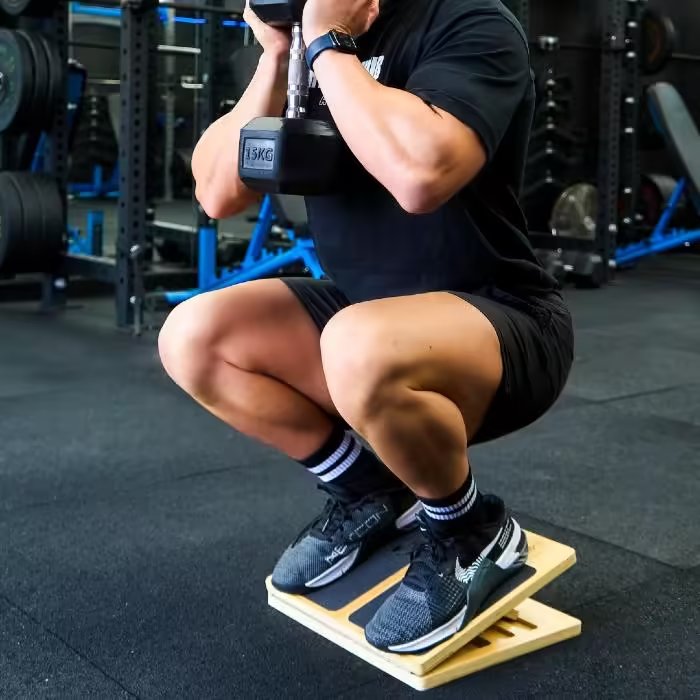
We can’t talk about knees-over-toes methodology without mentioning the slant board benefits. This simple, yet incredibly effective piece of exercise equipment has a lot more to offer than just heel-elevated squats.
If you’re looking for an efficient way to bulletproof your knees and prevent sports injuries, the slant board should be your first stop.
Let’s talk about it.
Table of Contents
What is A Slant Board?
As the name suggests, the slant board is a safe inclined surface that you can use for heel-elevated exercises and stretching.
The Hybrid Athlete Slant Board is made of natural materials (multilayered wood) and it’s covered with anti-slip materials on top.
One of the best features of our slant board is that its angles are adjustable. You can set it in one of 3 default positions – 20°, 30°, and 40°. This allows not only for versatility, but also gives beginners a chance to get used to heel-elevated squatting.
Lastly, our Slant Board closes easily, which is a great feature if you’re low on space at home. Just fold it to 0° and store it away.
What is a Slant Board used for?
The main purpose of every slant board is to provide you with a steady inclined surface for heel-elevated squatting. But that’s not all, by far.
To reap the most slant board benefits, you should consider other slant board exercises, like:
- Slant board pistol squats
- Poliquin step-ups
- Jefferson curls
- VMO squats.
- Slant board tibialis raises
On top of this wide range of lower-body exercises, the slant board is also great for calf and posterior chain stretching. But the bigger part of slant board benefits lies in heel-elevated squatting.
To read about these exercises and reap the most slant board benefits, make sure to check out our Slant Board Exercises guide.

Slant Board Benefits
Now, every athlete trains differently, not to mention body proportions and athleticism levels. But since the slant board is extremely beginner-friendly, you can reap slant board benefits no matter where you are on your journey.
Here’s a list of slant board benefits you can expect only a few weeks after you start actively using it:
- Enhanced ankle dorsiflexion
- Gains in your quads and hams, especially your VMO
- Lower-body strength gains, especially around the joints (ankles, knees, and hips)
- Better overall balance and proprioception due to finer muscle targeting
Squat Wedges vs Slant Board
Squat wedges are also an exercise tool designed for heel-elevated squatting. However, there are differences between them and the slant board:
- Squat wedges can handle the heaviest of barbell squats (think 100kg+) with ease, and you can set them to your perfect squat stance.
- The slant board offers you more incline angles, making it great not only for weight training but also excellent for stretching.
You can read more about it in our Slant board vs Squat Wedges quick guide.
Conclusion - Don’t Sleep On The Slant Board Benefits
If you’re an athlete who wants to stay healthy and injury-free, please don’t miss out on the slant board. It helps tackle the weak spots around your ankles, knees, and hips while boosting your overall mobility.
At the end of the day, nothing can make up for good old strength and mobility, and the slant board is the perfect tool to develop it.
Get The Best Knees-Over-Toes Training Equipment At Our Shop:
GET THE BEST INJURY-PREVENTION TRAINING EQUIPMENT:
Above all, a storyteller. Then comes marketing, branding, writing music, powerlifting, and woodworking.








1 thought on “Slant Board Benefits: Elevate Your Heels to Bulletproof Your Knees”
It’s hard to find reliable info on bulletproofing, so I’m happy I stumbled across Hybrid Athlete. Looking forward to getting my slant board, it seems sturdy! Thanks for the exercise ideas.